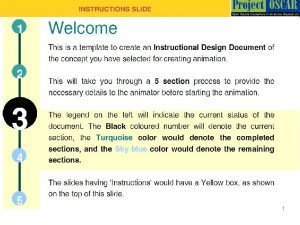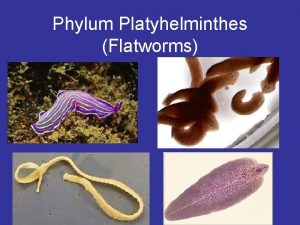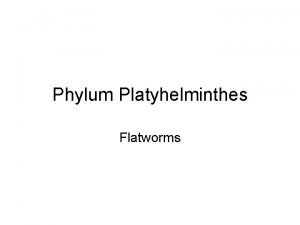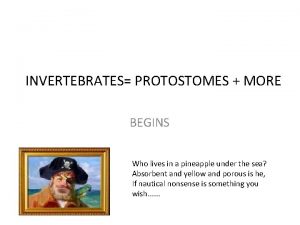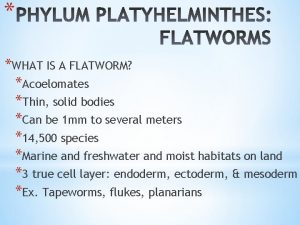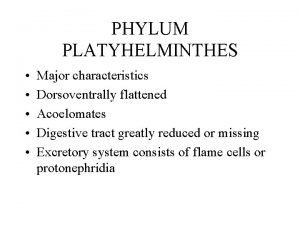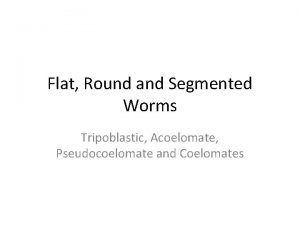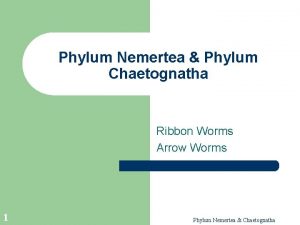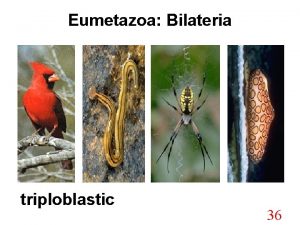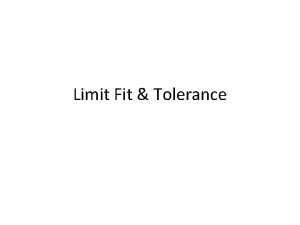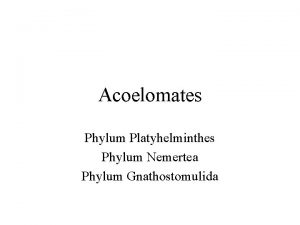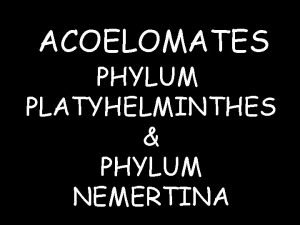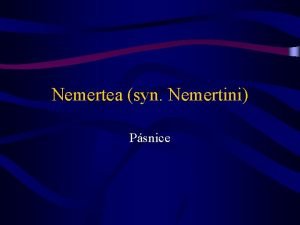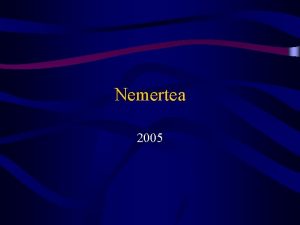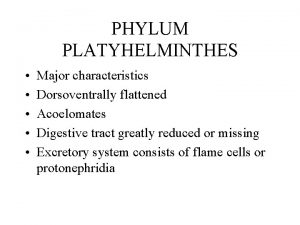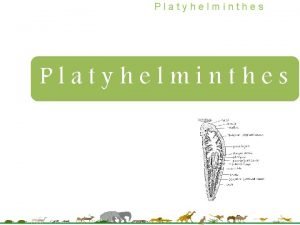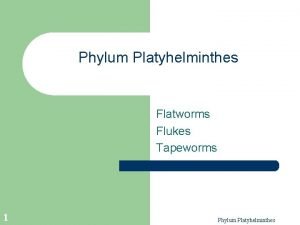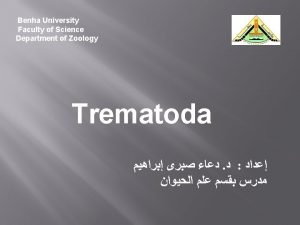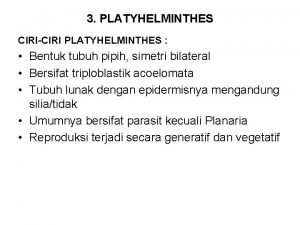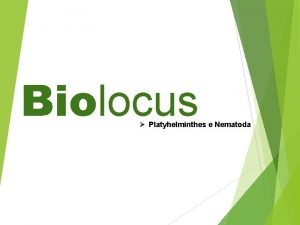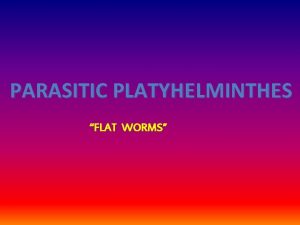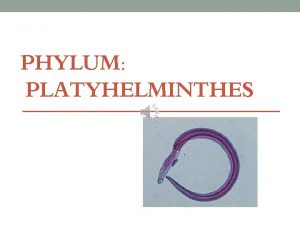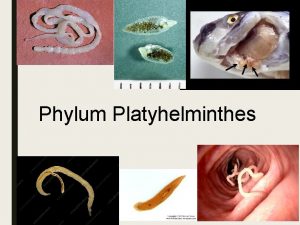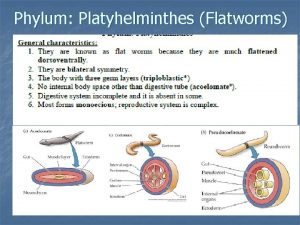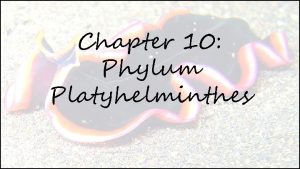How do the acoelomates fit in Nemertea Platyhelminthes










































- Slides: 42

How do the acoelomates fit in? Nemertea Platyhelminthes acoelomate Complete digestive system acoelomate Cnidaria Porifera Closed circ. system Ladder-like nervous system proboscis cephalization protonephridia organ level of organization triploblastic unknown common ancestor

How do the Pseudocoelomates fit in? Nematoda the pseudocoelomates Platyhelminthes Cnidaria Porifera unknown common ancestor Nemertea Rotifera

Pseudocoelomates There are 9 different phyla that are classified as pseudocoelomates. We are only covering 2 phyla: Nematoda Rotifera

Pseudocoelomate Characteristics Organ level of organization Tissues are organized to for organs which are used to accomplish physiological functions Triploblastic 3 Germ Layers 3 Tissue Layers endoderm gastrodermis mesoderm ectoderm epidermis

Pseudocoelomate Characteristics “false” body cavity ectoderm pseudocoelom mesoderm Gut endoderm the pseudocoelom is lined by mesoderm on ONE side only

Pseudocoelomate Characteristics the pseudocoelom ectoderm • is a closed, fluid filled cavity • contains digestive, excretory, and reproductive structures • the fluid within acts as a circulatory system • the fluid within acts as a hydrostatic skeleton against which the muscles work

Pseudocoelomate Characteristics Bilateral Symmetry • with anterior and posterior ends Cephalization • concentration of sensory organs in the head of the animal

Pseudocoelomate Characteristics Digestive System • complete (they have an anus!) • some regional specialization Circulation System • no system (or organs) • performed by the pseudocoelom fluid

Pseudocoelomate Characteristics Eutely • each individual of a species has the same # of cells • growth occurs by cells getting bigger rather than dividing

Phylum Nematoda the roundworms

Physiology Life Style – Free-living – parasitic Digestion – complete system (have an anus) – some regional specialization (e. g. an esophagus)

Physiology Skeletal system - fluid in pseudocoelom acts as a hydrostatic skeleton Cuticle – covers body (secreted by epidermis + composed mostly of collagen) – functions as a primitive external skeleton

Physiology Movement – longitudinal muscles ONLY (results in “whiplike” motion) – No external/internal cilia even sperm don’t have flagella http: //www. devgen. com/devpage/largeimage/wild. html

Physiology Nervous system - cephalization, cerebral ganglia - dorsal and ventral nerve cords Circulatory system – No system (no organs) – performed by fluid in pseudocoelom Excretion – Renette glands

Physiology Reproduction Sexual – usually dioecious – often the sexes are sexually dimorphic (males and females look different) Males often have a spicule at the end of their tail used to insert their sperm into the female

Physiology Reproduction Sexual – usually dioecious – often the sexes are sexually dimorphic – internal fertilization – males have ameboid sperm

Ecology • There are >12, 000 species that are found in almost all habitats (marine, freshwater, underground, inside plants and animals, etc…). • They are also incredibly abundant. For example: • a m² of soil may contain >4 million nematodes • a decomposing apple may contain >90, 000 nematodes of a single species

Ecology • Many nematodes are important parasites of both plants and animals. parasite of soybean plants parasite of tomato plants

Parasites Eye worm (Loa loa): • transmitted by fly bites • larvae go through bloodstream • adults live in subcutaneous tissue

Parasites Intestinal roundworm (Ascaris): • transmitted by contaminated food • adults live in small intestine • it’s estimated that 20% of world’s population is infected (~1. 3 billion people) this intestine was completely blocked

Parasites Guinea worm (Dracunculus medinensis): • transmitted by infected copepods in drinking water • larvae move into the body cavity • female adult migrates to the subcutaneous tissue, causes an ulcer/blister, and releases eggs through hole when host comes in contact with water

Parasites Guinea worm (Dracunculus medinensis): • traditionally removed by winding the worm around a matchstick over the course of several days • this may be the basis for the Caduceus symbol used in the medical field

Parasites Trichinella spiralis: • causes Trichinosis • transmitted by eating undercooked pork • juveniles encyst within host muscle cells juvenile Host muscle cell

Parasites Heartworms (Dinofilaria immitis):

Ecology • The study of the model nematode C. elegans has resulted in important discoveries in genetics and development.

Phylum Rotifera the rotifers

The “wheel” animals

Physiology Feeding – have a “crown” of cilia called a corona – the corona creates a current to bring food into the mouth

Physiology Feeding – have a specialized feeding structure called the: mastax-trophi complex modified jaws within the mastax a modified muscular pharynx

Looking down into the corona….

Physiology Some of the trophi (jaws):

Physiology Life Style – Free-living Digestion – complete system (have an anus) – some regional specialization (e. g. mastax-trophi complex)

Physiology Skeletal system - fluid in pseudocoelom acts as a hydrostatic skeleton Movement – the corona – pedal glands (produce adhesive), as well as foot and toe (spurs) for attachment to substrate

Physiology Nervous system - cephalization, cerebral ganglia - dorsal and ventral nerve cords Circulatory system – no system (no organs) – performed by fluid in pseudocoelom Excretion – protonephridia and flame cells – cloacal bladder (collects wastes)

Physiology Reproduction Sexual - complex life cycle with different types of eggs - usually dioecious but in some groups, males are absent (parthenogenesis) - Parthenogenesis: unisexual reproduction where females produce offspring from unfertilized eggs (virgin birth)

Physiology • 2 types of eggs: amictic & mictic Amictic eggs • diploid (mitotically produced) • can’t be fertilized • develop into diploid, amictic females

Physiology Mictic eggs • • haploid (meiotically produced) produced after some sort of environmental stimulus (eg. high density, change in temperature) Ø if unfertilized, develop into haploid males Ø if fertilized, secrete a thick, protective shell until the environment is favorable again, after which they develop into diploid, amictic females

Ecology • There are ~1500 species. Although they are found mainly in freshwater habitats, there a few marine rotifer species and a couple of species are even found in mosses! • Because of the reduced role of males in reproduction, most males are incapable of feeding and do not even have a digestive tract (they are just there for sperm delivery!). • Males have never been recorded in Bdelloid rotifers. This means they haven’t had sex in millions of years!

Here are some of the other pseudocoelomate phyla

Loricifera Nematomorpha Kinorhyncha Priapulida

Acanthocephala Gastrotricha Entoprocta

How do the Pseudocoelomates fit in? Nematoda Rotifera no cilia longitudinal muscles only Platyhelminthes Nemertea mastax-trophi corona m o l oe c do u e ps Cnidaria Porifera complete digestive system organ level of organization triploblastic unknown common ancestor
 First fit next fit best fit worst fit
First fit next fit best fit worst fit Aselomata
Aselomata Are flatworms acoelomates
Are flatworms acoelomates First fit memory allocation
First fit memory allocation Mr krab spongebob
Mr krab spongebob Are flatworms acoelomates
Are flatworms acoelomates Monogenea
Monogenea Acoelmate
Acoelmate Chaetognatha diagram
Chaetognatha diagram Nemertea life cycle
Nemertea life cycle Eumetazoa phylum
Eumetazoa phylum Limit fit tolerance
Limit fit tolerance Person-job fit and person-organization fit
Person-job fit and person-organization fit ưu thế lai là gì
ưu thế lai là gì Thẻ vin
Thẻ vin Frameset trong html5
Frameset trong html5 Thể thơ truyền thống
Thể thơ truyền thống Cái miệng nó xinh thế chỉ nói điều hay thôi
Cái miệng nó xinh thế chỉ nói điều hay thôi Các châu lục và đại dương trên thế giới
Các châu lục và đại dương trên thế giới Bổ thể
Bổ thể Từ ngữ thể hiện lòng nhân hậu
Từ ngữ thể hiện lòng nhân hậu Diễn thế sinh thái là
Diễn thế sinh thái là Tư thế ngồi viết
Tư thế ngồi viết V cc
V cc 101012 bằng
101012 bằng Hát lên người ơi
Hát lên người ơi Khi nào hổ mẹ dạy hổ con săn mồi
Khi nào hổ mẹ dạy hổ con săn mồi đại từ thay thế
đại từ thay thế Vẽ hình chiếu vuông góc của vật thể sau
Vẽ hình chiếu vuông góc của vật thể sau Công thức tiính động năng
Công thức tiính động năng Tỉ lệ cơ thể trẻ em
Tỉ lệ cơ thể trẻ em Thế nào là mạng điện lắp đặt kiểu nổi
Thế nào là mạng điện lắp đặt kiểu nổi Dạng đột biến một nhiễm là
Dạng đột biến một nhiễm là Lời thề hippocrates
Lời thề hippocrates Vẽ hình chiếu đứng bằng cạnh của vật thể
Vẽ hình chiếu đứng bằng cạnh của vật thể độ dài liên kết
độ dài liên kết Quá trình desamine hóa có thể tạo ra
Quá trình desamine hóa có thể tạo ra Môn thể thao bắt đầu bằng chữ đua
Môn thể thao bắt đầu bằng chữ đua Khi nào hổ mẹ dạy hổ con săn mồi
Khi nào hổ mẹ dạy hổ con săn mồi điện thế nghỉ
điện thế nghỉ Nguyên nhân của sự mỏi cơ sinh 8
Nguyên nhân của sự mỏi cơ sinh 8 Trời xanh đây là của chúng ta thể thơ
Trời xanh đây là của chúng ta thể thơ Gấu đi như thế nào
Gấu đi như thế nào
